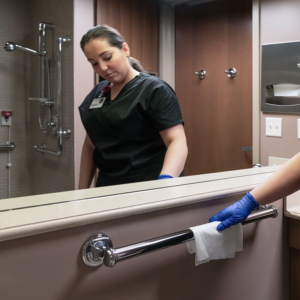Interventional Care


We notice that you are visiting us from . This site only services US-based visitors. Would you like to visit the site that is appropriate for your location?

Microbial bioburden of inpatient and outpatient areas beyond patient hospital rooms authored by Cadnum JL, Peralmutter BS, Jencson AL, Haydar H, Hecker MT, Ray AJ, Tomas ME, Saade EA, Donskey CJ.
The contaminated surface environment in hospitals plays an important role in the transmission of several key healthcare-associated pathogens including methicillin-resistant S. aureus (MRSA), vancomycin-resistant enterococci (VRE), Acinetobacter, norovirus, and C. difficile. All these pathogens have been demonstrated to persist in the environment for days (in some cases months), frequently contaminate the environmental surfaces in rooms of colonized or infected patients, transiently colonize the hands of healthcare personnel, be transmitted by healthcare personnel, and cause outbreaks in which environmental transmission was deemed to play a role. In contrast to data on contamination of surfaces in inpatient rooms, there is relatively little information about the presence of healthcare pathogens outside the patient rooms. In this study, the investigators evaluated the microbial burden of bacterial pathogens (MRSA, VRE, C. difficile, and gram-negative bacilli) and Candida spp. on surfaces in four Cleveland area hospitals, 4 outpatient clinics, and 1 surgery center.
An environmental assessment was performed via 3 point-prevalence surveys in each facility using cellulose sponges. In hospitals, high-touch surfaces were sampled from radiology, physical therapy, portable equipment, emergency departments, waiting rooms, subspecialty clinics, and endoscopy facilities. In outpatient facilities, surfaces were sampled in exam rooms including patient and provider areas, patient bathrooms, and waiting rooms, and from portable equipment.
In the hospitals, 9.4% (110/1,195) sites were positive for 1 or more bacteria pathogens and 5.9% (70/1,195) were positive for Candida spp. For the composite of bacterial pathogens, the waiting rooms had the highest frequency of contamination (14.2%) and the clinics were the least contaminated (4.7%). Based on fluorescent marker removal, <40% of the sites assessed had been cleaned in the previous 24 hours.
In outpatient facilities, 6.4% (31/485) sites were positive for 1 or more bacterial pathogens and 10.3% (50/485) were positive for Candida spp. The percentage of contaminated surfaces for the composite of bacterial pathogens in the outpatient clinics was lowest for clinic 4 and the surgery center (1.9% and 2.0%) and highest in clinic 1 (15.4%). Interestingly, the percentage of fluorescent marker removal was substantially higher in surgery and clinic 4 (82.5%, 63.6%) compared to clinic 1 (7.4%). Based on the fluorescent marker removal from surfaces, cleaning procedures were variable and suboptimal in the areas evaluated.
Surfaces in hospitals outside patient rooms and in outpatient facilities were frequently contaminated with healthcare-associated pathogens. This highlights the need for continued Improvements in disinfection practices to reduce microbial contamination.
Disclosure: Dr. Rutala is a consultant for PDI.
Cadnum JL, Peralmutter BS, Jencson AL, Haydar H, Hecker MT, Ray AJ, Tomas ME, Saade EA, Donskey CJ. Microbial bioburden in inpatient and outpatient areas beyond patient hospital rooms. Infect Control Hosp Epidemiol 2021 Jul 23;1-5. do: 10.1017/ice.2021.309